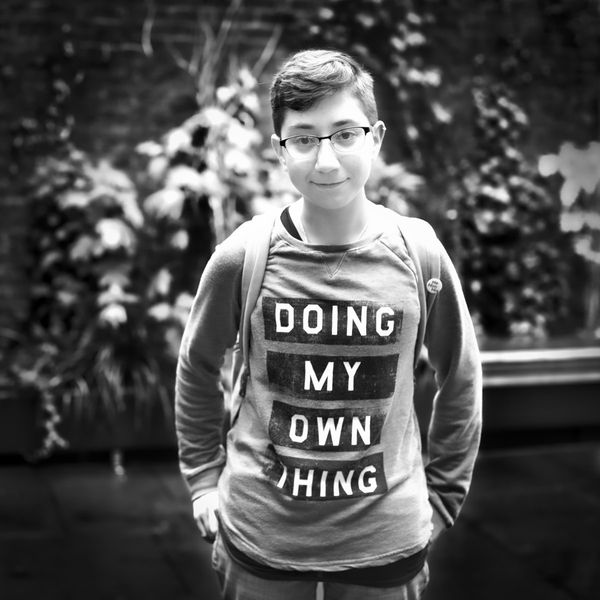One day, I was standing on the back of my pickup truck and throwing away trash at the town dump when I had an experience that’s hard to describe. My head was swimming, my body felt electrified and I felt detached from the world and myself. A memory then trickled in: I was nine years old, being hit repeatedly by my father one evening because he thought I had lost a 25-cent screwdriver. I remember being scared that he was going to kill me. I remember going numb.
Thirty years later, there I stood, scared and numb again—wondering how or what to do to get out of this state, wondering if I would ever “come back.” I was by myself that day, and not only was nobody home, but I had no one to call. None of my friends had the kind of inclination toward giving me the help I needed, and I also wasn’t in therapy at the time. I was stuck—in more ways than one.
It would take me quite a while before I learned how to soothe myself when I wasn’t doing so well. And I’m still not always the best at it. The old phrase of “physician, heal thyself” rings true for me. Being a therapist, I sometimes think, “Jeez, if my clients knew how difficult it is for me to calm myself down sometimes, I’m not sure they’d keep coming to me.”
Working Through Challenging Symptoms
Therapist or not, learning to self-soothe is hard, but it’s something we all should learn how to do—especially if we have mental health conditions or traumatic pasts. Over the years, I’ve mostly grown past, but I’ve never forgotten, the harshness of my father. That doesn’t mean all my insecurities have gone away, and I don’t expect they ever will; it just means that I’ve concentrated on working toward being independent enough from my experiences. That way, I don’t get so wrapped up in my symptoms of depression and anxiety, and in the fears I still carry around.
Instead of being ruled by these symptoms like I have in the past, I have “worked” psychologically, spiritually and practically to learn and practice the art of self-soothing. I remember when I first started practicing, I latched on to one technique, thinking it would be the answer: breath. I would sit quietly, usually in the morning, and I would breathe in and out, paying attention to the noise of my breath passing through my nostrils. When I became aware of my mind wandering, I would try to refocus. I found this exercise helpful—for a little while.
The sense of peace and calm I once got during the exercise vanished one day, so, I started looking for other ways to self-soothe. This became my pattern. I try a self-soothing exercise, and it either helps me or it doesn’t, then after a stretch of time, I move on to something else.
Over the years, I’ve tried numerous self-soothing techniques. For about a year-and-a-half, I did daily meditations from A Course in Miracles, and once it became too spiritual for me, I stopped. I rode my bicycle for a couple of years. I took up “intentional walking” (a kind of meditation in movement). I tried yoga. I attended spiritual retreats. Jogging was more work than soothing. Walking did not work when I was in my 40s, but was effective in my 50s. Sitting quietly with my legs crossed in meditation was more painful than anything. Qi Gong was not helpful. Tai Chi did not work.
Now, in addition to swimming at the YMCA a few times a week, I meditate while stretching for about 30 minutes in the morning. I also read, at times, from spiritual, poetry or philosophy books, and when I get an “ah-ha” moment, I stop and repeat that saying or sentence or concept throughout the day. I also like to go to the movies and “lose myself” in what’s happening on the screen.
Getting Started
I think one of the most important aspects of self-soothing I’ve discovered is that not every technique works for everyone and it’s unlikely that one technique will be the only technique you ever use. I know that I will likely continue using different techniques, probably for the rest of my life. My initial belief that I would find “one answer” to my anxiety, obsessions and fears was a myth.
I see that a lot in my practice, as well. People want one solution to feel better: one medication, one single action to solve all their problems. The fact is, that’s not how life works. We have to try all kinds of solutions; some will work, some won’t, and some might for a period of time and then stop. Some might not work now, but might later.
That’s a difficult concept to get across to clients and even to myself. I want to feel better right now and forever. But that’s unrealistic. That’s why part of therapy is helping people be realistic in their expectations and to realize that growth, becoming more peaceful and calm as well as happier, is a process that evolves over time. Self-soothing is one of those things as well: It evolves over time. If you’re going to take on learning the art of self-soothing, I have a few pieces of advice.
Realize The Value
Too many of my clients hesitate to take time away from our sessions to practice self-soothing. They have convinced themselves there is little value in learning how to calm themselves when actually, self-soothing can help the recovery process immensely. When you are upset or stressed, it is important to know positive ways to cope on your own—that’s a skill important for our individual growth no matter who we are. Finding ways to self-soothe can help you feel at ease when you are dealing with frustration, excitement or having intense emotions. It can also reduce the amount of worry and fear we carry around with us.
Use Simple, Everyday Experiences
You don’t need to be a guru on the mountaintop raking sand to self-soothe “the right way.” A friend once told me she meditates when she irons. Try to think of something simple you do that you can focus on to relax and find some peace of mind, even if just for a short time.
Adopt A Calming Word Or Phrase
Finding words or phrases that help shift you to a calmer state is like having the right tools for a job. You can find these words, phrases or concepts by reading books or articles or daily meditations, by listening to podcasts or videos, or by making them up yourself. When you find something that makes you feel at ease, stop reading or listening and repeat it a few times to commit it to memory. Repeat the word or phrase periodically throughout the day during stressful and non-stressful times; it will likely bring you a sense of calm.
Practice Makes Perfect
Self-soothing is like any other exercise. The more we do it, the better we get at it. You don’t practice running for a marathon by only running the marathon. You practice by jogging shorter distances and building up stamina. When we practice self-soothing techniques even when we don’t “need” them, we are building a skill and more of an automatic response for when we do need them.
Therapy Can Help
I have used therapists in the past as coaches, supports and idea-generators. My therapists have given me great insight into the kinds of situations that trigger me, and helped me learn how to manage those triggers. Learning to manage my triggers reduces the need to self-soothe in the first place.
As you begin this adventure, remember to be patient. Self-soothing is a skill that develops over time. I’m still learning. But through my learning, self-soothing has helped me be calmer in my day-to-day interactions with people, and I’ve found that I’m more prepared for experiences like the one I had in the back of that pick-up truck.
Learn how to soothe yourself. It could make a difference in your life. I know it did for me.
Larry Shushansky has helped thousands of individuals, couples and families over 35 years as a counselor and public speaker. He has developed the concept of Independent Enough and shares this when giving talks to businesses, nonprofit organizations and educational institutions. Learn more about him at www.independentenough.com.
https://www.nami.org/Blogs/NAMI-Blog/June-2018/A-Therapist-s-Journey-Learning-the-Art-of-Self-So







